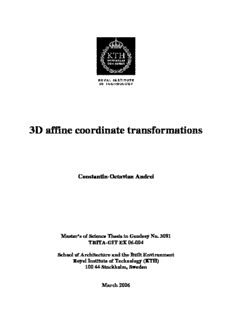Table Of Content3D affine coordinate transformations
Constantin-Octavian Andrei
Master’s of Science Thesis in Geodesy No. 3091
TRITA-GIT EX 06-004
School of Architecture and the Built Environment
Royal Institute of Technology (KTH)
100 44 Stockholm, Sweden
March 2006
Abstract
This thesis investigates the three-dimensional (3D) coordinate transformation from a global
geocentric coordinate system to a national terrestrial coordinate system. Numerical studies are
carried out using the Swedish geodetic data SWEREF 93 and RT90/RH70. Based on the
Helmert transformation model with 7-parameters, two new models have been studied: firstly a
general 3D affine transformation model has been developed using 9-parameters (three
translations, three rotations and three scale factors) and secondly the model with 8-parameters
(three translations, three rotations and two scale factors) has been derived. To estimate the 3D
transformation parameters from given coordinates in the two systems, the linearized
observation equations were derived. Numerical tests were carried out using a local (North,
East, Up) topocentric coordinate system derived from the given global geocentric system. The
transformation parameters and the residuals of the coordinates of the common points were
computed. The investigation shows the horizontal scale factor is significantly different by the
vertical scale factor. The residuals of the control points were expressed in a separate (North,
East, Up) coordinate system for each control point. Some investigations on the weighting
process between horizontal and vertical components were also carried out, and an optimal
weighting model was derived in order to reduce the residuals in horizontal components
without changing the coordinates.
Keywords: Affine transformation ▪ scale factor ▪ translation ▪ rotation ▪ least squares
adjustment ▪ weight ▪ residual.
i
Acknowledgements
I wish to express my gratitude to all who have contributed to the completion of this master
thesis.
First and foremost, I like to express my sincerest gratitude to my supervisor and the director
of the master’s programme, Huaan Fan, for his guidance and encouragement during the thesis
work. I am indebted to him for all the discussions and his valuable comments (not only
regarding the thesis).
I am grateful to the Swedish Institute for the financial support they made available for my
graduate studies. This degree could not have been initiated and completed without this
support which played a crucial role by allowing me to concentrate my full effort on the
studies.
I also would like to extend my gratitude to Professor Gheorghe Nistor, Technical University
of Iasi, Romania, for all the encouraging guidance during both the student period and as his
assistant and for initializing my first contact with Huaan Fan.
I would like to express my gratitude to Professor Lars E. Sjöberg, Division of Geodesy, KTH,
my examinator of this Master of Science Thesis.
I finally wish to thank all my master’s colleagues for their friendship and a pleasant time
during my stay at KTH.
iii
Contents
1. Introduction..................................................................................................1
1.1. Affine transformations............................................................................................1
1.2. Similarity transformations......................................................................................2
1.2.1 Bursa-Wolf model......................................................................................2
1.2.2 Molodensky-Badekas model.......................................................................5
1.3. Thesis Objectives...................................................................................................7
2. Affine transformation with 9-parameters.....................................................9
2.1 General Model........................................................................................................9
2.2 Least squares estimation of the transformation parameters.....................................11
2.2.1 Linearization of the rotation matrix............................................................11
2.2.2 The scale factors matrix.............................................................................13
2.2.3 Linearization of the observation equations.................................................14
2.2.4 Least squares estimates of the transformation parameters...........................16
2.2.5 Least squares estimates of the residuals.....................................................16
3. Affine transformation with 8-parameters....................................................19
3.1 Least squares adjustment with constraints..............................................................19
3.2 Derived formulas in 8-parameter model.................................................................21
4. Numerical tests...........................................................................................25
4.1 Preparation of numerical tests................................................................................25
4.2 Tests for 7 –, 8 – and 9 – parameter model............................................................29
4.3 Optimal weighting.................................................................................................34
5. Conclusions................................................................................................39
6. References...................................................................................................41
7. Appendices.................................................................................................43
Appendice A – North, East and Up components of the residuals of the common
transformation points, using different weighting approach for the vertical datum in
least square adjustment model...............................................................................43
v
Appendice B – General algorithm of 3D coordinate transformation with all the
subroutines...........................................................................................................46
vi
List of Tables
Table 4.1: Geocentric rectangular coordinates of the common points....................................26
Table 4.2: Local topocentric coordinates of the common points. The origin of the topocentric
coordinate reference frame is assumed to be the barycentre of the network.........30
Table 4.3: Transformation parameters and their standard errors when geocentric coordinates
are assumed to be used in the transformations.....................................................31
Table 4.4: Transformation parameters and their standard errors in the local coordinate system
with the origin in the barycentre of the network..................................................31
Table 4.5: Residuals in the local topocentric coordinate system when its origin is considered
the point itself after a conventional transformation model...................................34
Table 4.6: RMS of the residuals for each component with respect to different values of the
variance of the vertical datum.............................................................................36
Table 4.7: Residual after an optimal 8-parameters transformation model has been carried out37
vii
List of Figures
Figure 1.1: Three-dimensional transformation........................................................................3
Figure 4.1: Global geocentric and local level coordinate systems.........................................26
Figure 4.2: Components of the position vector in the local level system...............................27
Figure 4.3: The trend of RMS of the horizontal vector residual when different weights are
used for the vertical datum in the least squares adjustment.................................36
Figure 4.4: North, East and Horizontal components of the residuals of the common
transformation points for a “conventional” 8-parameter model and an “optimal”
8-parameter model, respectively........................................................................38
viii
Description:1.2.1 Bursa-Wolf model . known Bursa-Wolf formula for three-dimensional Helmert transformation: )1.1(. )1(. 3. 2 . when deriving the parameters.

